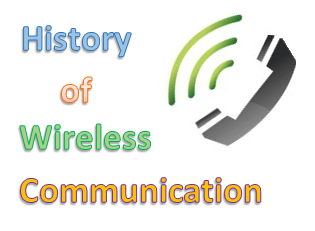History of Wireless Communication
In ancient times, light and flags were used for wireless communication. During the year 1794 Claude Choppe invented the optical telegraph with which long distance wireless communication was possible. But the optical telegraph system had certain drawbacks.
a. It used to suffer from high frequency of carrier lights.
b. It was not possible to focus the light efficiently.
To overcome these problems, Michael Faraday came up with another principle for mobile communication called electromagnetic induction during 1837. Almost during the same time C. Maxwell laid theoretical foundation to electromagnetic induction with his famous equation.
Hein Rich Hertz was the first to demonstrate the wave character of electromagnetic transmission through space, during 1886 and proved Maxwell’s equation.
Nicolatesla increased the distances of the electromagnetic transmission between the periods 1856 to 1943.
G. Markony demonstrated wireless telegraph in 1895 using long wave transmission with very high transmission power (2000 kilo watts). The first transatlantic transmission followed in 1901.

1) Laser in 1907, the first commercial transatlantic connections were setup. These required large have stations using up to 30 hundred meters high antennas on both sides of the Atlantic Ocean.
2) The first radio forecast took place in 1906 when R.A. Fessenden successfully transmitted voice and music for Christmas.
3) In 1950 the first wireless voice transmission was setup between New York and Sanfrancisco.
4) In 1950 the first commercial radio station also was started.
5) Again during 1920, Markony illustrated how short radio waves could be transmitted around the world bouncing at the ionosphere.
6) In 1926, the first telephone is a train was available on the Berlin Hamburg line. Wires parallel to the rail road track worked as antenna.
7) Gregorie Frost of Chicago at his 18 years of age integrated a radio into Ford model-T in 1922. It became commercially available in 1927.
8) During 1928, a number of attempts were made in the field of television broadcasting.
a. John L. Baird transmitted TV across the Atlantic and demonstrated color TV.
b. The WGY station of New York started regular TV Broadcast and the first TV news.
c. The CBS station started Tele Teaching for the first time during 1932.
d. The technique that was used during his period was amplitude modulation that resulted in poor quality of broadcasting.
e. Edwin H. Armstrong invented frequency modulation technique of wireless communication during 1933 that resulted in a better quality of broadcasting.
f. After the Second World War, many national and international projects in the area of wireless communication were triggered off.
g. In accordance with a general idea of a European union, the European countries decided a European mobile phone standard in 1982.
h. The new system aimed to use:
* A new spectrum at 900MHs.
* Allow roaming throughout Europe.
* The fully digital and
* Offer voice and data services.
To meet these requirements, the GSM was founded.
i. In 1983, the US started AMPS (advanced mobile phone system).
AMPS is an analog mobile phone system working at 850MHs.
j. Fully digital systems got available during the early 1990.
k. In 1991 ETSI adopted the DECT standard. It works at a spectrum of 1880 to 1980 MHz with a range of 100 to 500 meters.
l. GSM was standardized during 1991. The first version of GSM worked at 900 MHz it offered full international roaming, automatic location services, authentication, encryption of the wireless link, efficient inter operation with ISDN systems and relatively high audio quality. Furthermore a short message service up to 16 alpha numeric characters and data services of 9.6 kbp/sec were integrated. Up to now, over 400 service providers is more than 1990 countries have adopted the GSM standard.
Is the US, different companies develop different high Bandwidth technologies to operate side by side with AMPS that operates in the same bandwidth. This resulted in 3 important technologies via.
1. The analog narrow Band AMPS.
2. TDMA
3. CDMA Digital technologies
The Europeans decided to use GSM in 1800 MHz spectrum which was called DCS (Digital cellular system).
In US, GSM was used in 1900 MHz spectrum called PCS (Personal cellular systems).
m. During 1998, mobile communication was achieved used satellites with the iridium systems.
Iridium consists of 66 satellites in low earth orbit and uses 1.6 GHz bandwidth.
n. During the same year, the Europeans agreed on UMTS.
o. During 1999, several powerful WLAN systems were evolved, such as Bluetooth that uses 2.4MHz spectrum.
p. WAP (Wireless Application Protocol) and I-mode of Japan were starting during the same time. Initially WAP did not succeed while I-mode became popular.
Average Acceleration Calculator
Average acceleration is the object's change in speed for a specific given time period. ...
When an object falls into the ground due to planet's own gravitational force is known a...
In Mathematics, the permutation can be explained as the arrangement of objects in a particular order. It is an ordered...
A rectangle can be explained as a 4-sided quadrilateral which contains equal opposite sides. In a rectangle
A three sided polygon which has three vertices and three angles is called a triangle. Equilateral triangle...







